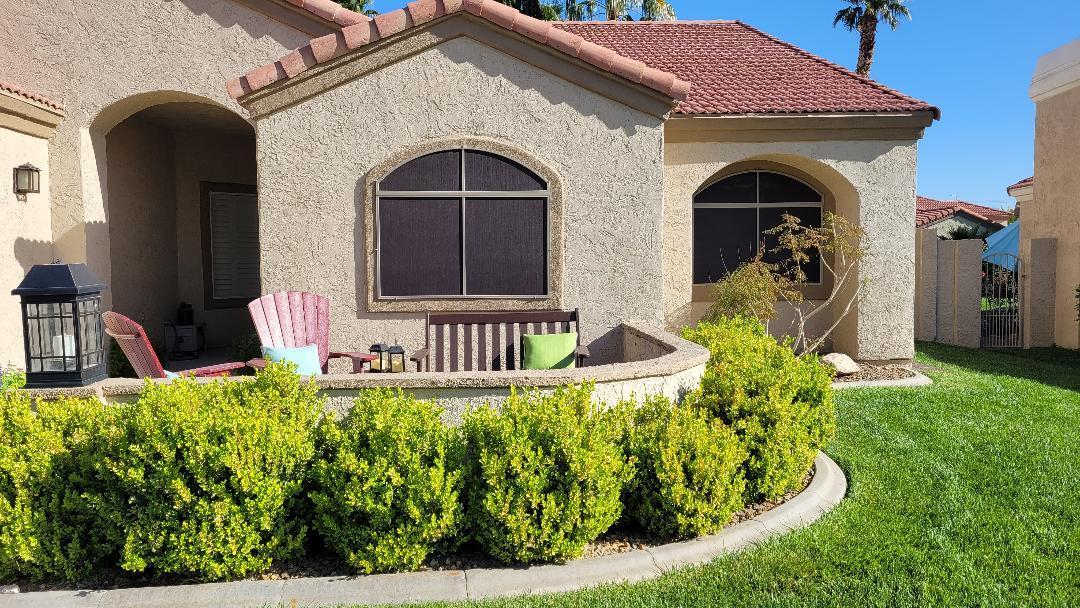
Why Solar Screens Are Ideal for Single-Story Homes in Hot Climates
In regions where the sun blazes nearly year-round—like Las Vegas or Phoenix—homeowners are constantly looking for smart ways to cool their homes without skyrocketing their energy bills. For single-story homes in particular, solar screens are one of the most effective, affordable, and low-maintenance solutions on the market.
This article explores why solar screens are especially well-suited for single-story homes in hot climates. We’ll break down how they work, why they’re more efficient on single-level properties, and how they stack up against other window treatments.
Why Solar Screens Work So Well in Hot Climates
Solar screens are exterior-mounted mesh screens designed to block a significant portion of solar heat and UV rays before they ever reach your window glass. In hot climates, this small barrier makes a massive impact on indoor temperature and energy usage.
Here’s what makes them such a good fit:
They Stop Heat Before It Hits the Glass
Unlike interior treatments like blinds or curtains, solar screens work from the outside in. That means they reduce solar gain before the heat has a chance to warm the interior of your home. By blocking up to 90% of solar radiation, they dramatically reduce indoor temperature spikes during hot afternoons.
They Cut Down on AC Usage and Utility Costs
In hot climates, a large chunk of your electric bill comes from air conditioning. By filtering heat at the window, solar screens ease the load on your HVAC system. Most homeowners in desert regions report noticeable reductions in cooling costs—sometimes as much as 20–30% during peak months.
They Allow Natural Light Without the Heat
One of the best aspects of solar screens is that they allow diffused natural light inside while blocking heat and glare. You don’t have to sacrifice daylight to stay cool, and during the day, they provide privacy from outside views without darkening your space like blackout curtains would.
They Prevent UV Damage to Interior Surfaces
In sunny regions, UV rays can quickly cause fading and deterioration of floors, furniture, and fabrics. Solar screens protect your investments by limiting the sun’s reach indoors, extending the life of everything from hardwood floors to your favorite couch.
Why Single-Story Homes Benefit the Most
While solar screens can work on any residential property, single-story homes see some of the biggest gains. Here’s why:
Most Windows Are Fully Exposed to the Sun
In single-story homes, windows are often larger and more directly exposed to sunlight. Unlike multi-level homes with overhangs or shaded floors, there’s less structural shielding. That means windows absorb more heat—especially on south- and west-facing walls. Solar screens create a physical barrier that reduces this load.
Easier, Safer, and More Cost-Effective to Install
Because everything is at ground level, solar screens are easier to measure, fabricate, and install on single-story homes. This usually results in lower labor costs, simpler logistics, and faster completion times. There’s also less need for special equipment or extra crew members.
More Uniform Aesthetic and Full-Coverage Protection
Installing matching screens across a single-story home creates a consistent, polished look that complements curb appeal. Multi-level homes often need custom screen sizes for higher windows or architectural offsets, which can interrupt the visual flow and increase costs.
More Impact on Interior Comfort
Single-story homes typically have more open floor plans, which means more sunlight travels deeper into the home. By stopping solar heat at the perimeter, screens protect a larger portion of the living space from overheating.
What Homeowners Should Know Before Installing
Installing solar screens on a single-story home is straightforward, but there are still a few important considerations to ensure long-term performance and maximum savings.
Step 1: Evaluate Your Sun Exposure
Focus on windows that face south and west first. These receive the most intense sun throughout the day. Screens on these sides will make the biggest difference in comfort and energy efficiency.
Step 2: Choose the Right Openness Level
Most solar screens come in 80% or 90% blockage options. If your goal is to reduce heat while preserving light and views, 80% may be the right balance. If you're prioritizing maximum UV protection and privacy, 90% offers the best performance.
Step 3: Get a Custom Fit
One-size-fits-all rarely works in home improvement. Professionally measured and fabricated screens ensure that your windows are covered edge to edge, with no gaps that let heat sneak in.
Step 4: Consider Long-Term ROI
While upfront costs vary based on window size and material, solar screens pay for themselves over time. Lower cooling bills, less wear on your HVAC system, and protected interior furnishings all contribute to a return on your investment.
Step 5: Choose a Local Expert
Working with a local installer who specializes in homes in your area ensures you get products that are made for your climate. In Las Vegas, for example, companies familiar with desert sun and single-story construction can provide better screen placement advice and more durable material options.
Conclusion
For homeowners in hot climates, solar screens are a simple yet powerful way to reduce indoor heat, protect your property, and lower utility bills. And for single-story homes, their benefits are amplified—thanks to better sun exposure, easier installation, and more consistent protection.
Whether you're trying to improve home comfort, cut long-term costs, or enhance curb appeal, solar screens offer one of the best returns in passive cooling and energy efficiency. If you live in a region where the sun never quits, they’re one of the smartest upgrades you can make to your home.